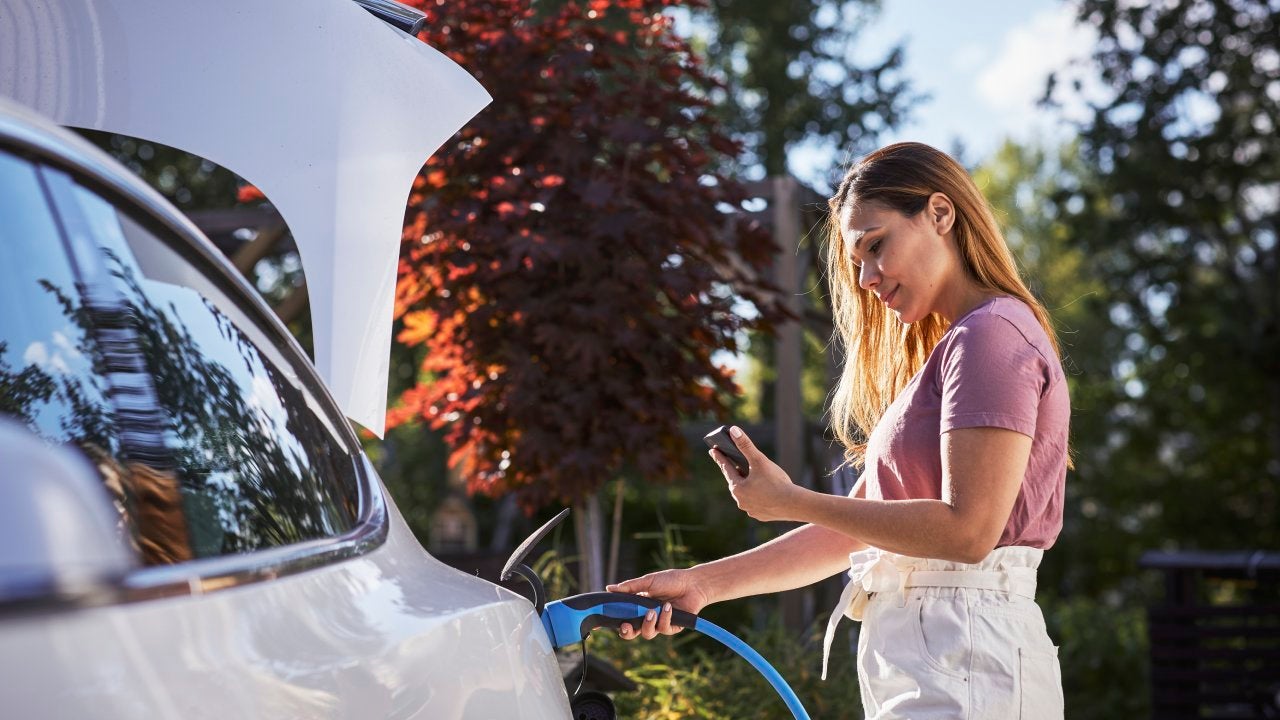Financing an EV might be more seamless than you think

As more legacy car manufacturers debut green cars, drivers are taking notice. A 2023 Cars.com study found that 50 percent of new car buyers are considering buying an electric one. Interest in driving electric also comes as more people are back to a daily commute and gas prices remain high.
Purchasing an electric car tends to carry a higher price — averaging $58,385 in February 2023, according to Kelley Blue Book. But we spoke to two happy EV owners who found Tesla dealership financing a convenient way to fund their EV dreams.
An EV driver’s top priorities
Back in 2019, when Kyle Getson decided it was time to trade in his Nissan, saving money on his commute each day was the main focus. He entered the car shopping process not with a “need a fancy car” attitude but rather was laser-focused on finding an energy-efficient EV.
Though the now proud owner of a Telsa Model 3, Kyle admits he did not intend to drive off in the popular EV brand.
“I’m not a showy person,” he says. “I’m not somebody who buys a fancy car or wears fancy clothes or does fancy things.”
But that all changed once he got behind the wheel for a test drive. As a self-proclaimed tech person, after seeing the ease of an app on your phone that can control everything from music to starting the vehicle, he was sold.
Similar to Kyle, Chad Cook purchased his Tesla with his much longer 40-mile commute in mind. Before settling on Tesla, he drove a Prius to manage his cost of commuting each day.
A gearhead himself, Chad switched over to a Camaro during the pandemic to enjoy the fun of the open road. But when it was time to return back to the office, purchasing the Tesla Model Y Performance married exciting handling with the perks of driving electric.
Convenience meets advanced technology
Those attracted to driving electric tend to have an appetite for a tech-centric drive. This was true for both Chad and Kyle, who appreciated the balance among a powerful driving experience, benefitting the environment and state-of-the-art technology.
Chad, who wanted to be at the forefront of available tech, signed off on Full Self-Driving Beta package. Essentially a software upgrade, this enables Tesla drivers to get new features without hardware updates.
Charging at home
Aside from the enjoyable drive and built-out technology, the ease of charging the vehicle serves to convince many to move towards electric. Both Telsa owners have chargers installed at their homes, Chad even saying that he wouldn’t have bought an EV if he couldn’t have a charger at home.
Installing an at-home charger does come with an additional cost, anywhere from $300 to $1,000 plus installation, according to J.D Power. But charging at home will cost you less over time. Chad noticed the steep difference between public stations and charging up at home.
“It’s like 11 cents per kilowatt hour at home versus a supercharger is 40 cents or more per kilowatt hour,” he said. Chad recalls spending $1 to $3 a day to charge, which is dramatically cheaper than not only a stop at the gas pump but also using a public charging station.
And some EVs, including Teslas, even give you data to help you increase your energy efficiency.
“The car is actually really smart,” explains Chad. “It tells you, hey, on this last drive, you lost 3 percent because of a southwest wind.” He mentions how the car tells you how you can maintain a charge even better, “like you lost 2 percent because your tire pressures are lower than they should have been.” Traditional gas-powered vehicles don’t offer such detailed data.
But the cost to install a charger at home shouldn’t hold you back from a life behind the wheel of an electric car. Instead, research to see whether there’s a nearby charger. Check out resources like Plugshare, which maps out charging stations nearby.
If you choose to go ahead with an at-home charger, be sure to take advantage of available tax credits. To claim the credit for the Alternative Fuel Vehicle Refueling Property credit, file Form 8911 with the IRS.
The expanding EV landscape
Just in the first three months of 2023, EV sales grew a whopping 32 percent, according to Cox Automotive. Economists estimate that 7 percent of new vehicles purchased in the first quarter of 2023 were electric. That is up from a mere 3.2 percent of new cars back in 2021.
With this in mind, now is a great time to explore EV options outside of just Tesla. Legacy car makers like Hyundai, BMW, Kia and Audi have all released well-regarded EVs in the last year. When shopping, consider hybrid versus electric options and even leasing if you are not ready to fully commit.
How to secure the best EV loan
While EV-specific lenders like Tenet exist, getting the best loan for your EV doesn’t require any process outside of the norm. When setting out to secure an EV auto loan, take the following steps.
- Improve your credit. Lenders emphasize your credit score when deciding rates: the better your credit history, the better your rates. And with EVs carrying higher costs, low rates are vital. Take the time to pay down debts and make timely payments before applying for a loan.
- Apply for loan prequalification. By applying for loan prequalification you will get a firm idea of your monthly cost without denting your credit score.
- Compare at least three quotes. Options for auto loans range from online lenders, credit unions and banks. To ensure you get the best rates and terms, gather at least three quotes before signing off on one.
- Apply. When it comes time to apply, you will need information on your finances, the vehicle and insurance.
- Sign off and begin making payments. Once you’ve signed off on your new loan it is wise to set up automatic payments to never miss a payment and be one step closer to making the vehicle all yours.
Dealership vs. lender financing
The question of where to secure financing for your EV comes down to finding the most convenient and inexpensive option. For both Kyle and Chad, Tesla’s in-house financing was the best match.
They basically sent me a link on my phone and they're like you can pay right there.— Kyle Getson
At the time, 2019 and 2021 respectively, Tesla not only presented borrowers with APRs in line with traditional lending competitors but also presented the ease of a completely online process. Even Chad — who had to wait two months during the pandemic for his vehicle to arrive — touted the process’s ease.
Kyle also recalled the convenience: “They basically sent me a link on my phone and they’re like you can pay right there.”
Chad shared a similar experience of signing off on a PDF on his phone and getting handed his keys right after.
Now in 2023, online lender options have multiplied. Many, like Lightstream and Carvana, offer a fully online experience to attract those who feel comfortable navigating payments without in-person support.
Dealership financing makes the entire process seamless, as purchasing and financing can be handled all in one place. But with interest rates the highest in years, it is important to shop around. Average rates stand at 6.07 percent for new and 10.26 percent for used cars, according to Experian fourth quarter data. You might be able to secure more competitive rates with banks or online lenders.
Now is a good time to consider an EV
With so many options available for electric vehicles, now is an excellent time to see if it is right for you. And while diving into a new class of vehicles may feel intimidating, those who value new tech will find it everywhere from the driver’s seat to the funding process.
You may also like

Why is it harder to get a car loan in 2023?

Should you get an 84-month Tesla loan?




